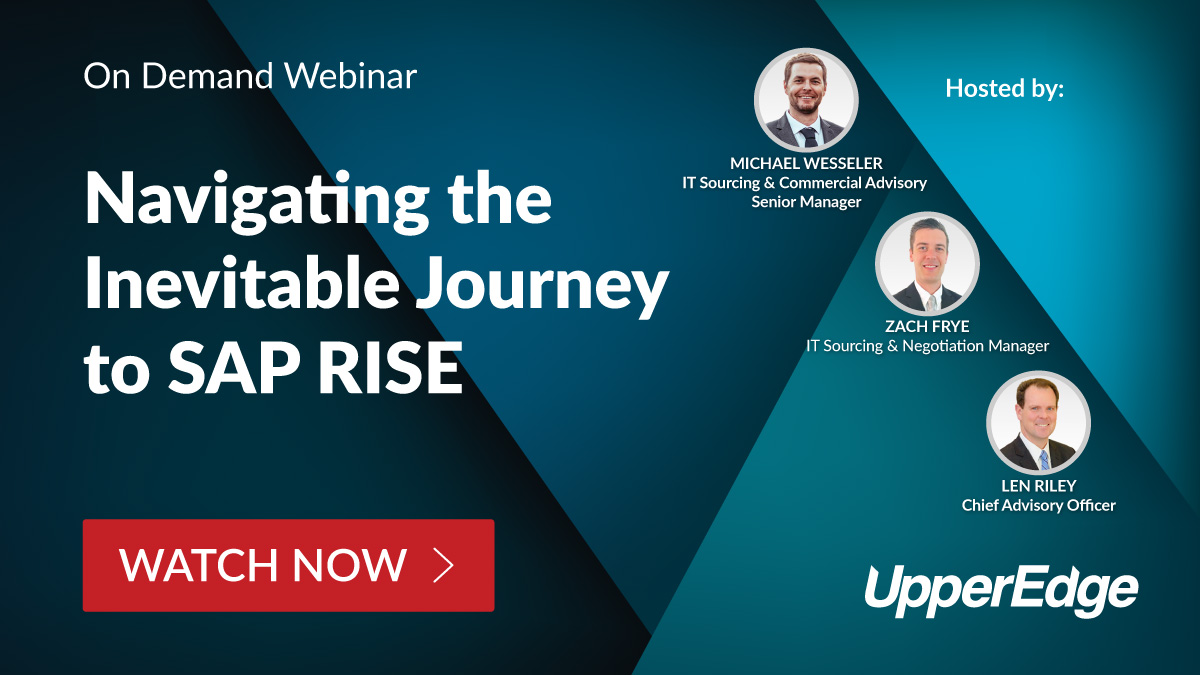- Chip Hanna
- Reading Time: 5 minutes

Over the past 2 years, we have seen how SAP RISE has played out in the market and how RISE has evolved in an attempt to better fit customers’ needs. We also have deeper insights into what customers need to know when SAP inevitably positions RISE sooner rather than later. This includes developing a comprehensive SAP RISE strategy.
With SAP aggressively creating opportunities to push clients to RISE and the 2027 deadline to move off SAP ECC quickly approaching, organizations are running out of time to conduct a proper assessment and are heading into RISE discussions unprepared. It is critical that SAP customers take a proactive approach to managing RISE as a potential eventuality for their SAP platform future.
To help you prepare to evaluate SAP RISE, some scenarios where we’ve seen RISE be a great fit, some situations where RISE may present challenges, and tactics SAP is using to position RISE that you should be aware of.
RISE Opportunities – When RISE is a Good Fit
There are several different types of customers that would benefit from moving to RISE. These customers include:
- Companies with Antiquated Technology Platforms: Companies that are looking to bring their technology into the present see an opportunity to do so by deploying RISE in a greenfield environment. Deploying RISE allows them to make this leap in one big step, eliminating the complexity of moving their technology forward several years.
- Existing SAP ECC Customers: RISE may be a good fit for ECC customers with disparate systems who want to avoid consolidating their systems in an on-premise model and then needing to make another leap from ECC to S/4HANA in the cloud. Leveraging RISE allows these customers to consolidate and move to the cloud in one big step with one end-state platform.
- Customers Outsourcing SMEs: Companies who have outsourced key roles or do not have the internal subject matter experts for SAP BASIS support and infrastructure support could also benefit from selecting RISE. RISE would allow customers who do not want to invest in “people costs” for S/4 to efficiently move forward in their transformational journey.
RISE Challenges – When RISE is Not a Good Fit
Despite how SAP may position RISE, there are customers who would not benefit from deploying. These customers include:
- Customers with Highly Customized Environments: High customizations in your ECC or S/4 environment and complex integrations face significant challenges implementing RISE. RISE has not evolved to expand or extend outside of a “clean core” which creates inherent inefficiencies from both an application and operational perspective.
- Customers with An Established IaaS Strategy: Customers who already have their own Infrastructure-as-a-Service (IaaS) strategy find it challenging to implement RISE, since RISE would create an island around their cloud strategy, which is unappealing to customers who already have their strategy in place.
- Customers Reliant on Third Party Providers: Since RISE came to market, customers are better realizing how RISE will impact their existing vendor relationships. Impacts to third-party providers performing BASIS support and application maintenance may add complexity, erode the commercial benefits and negatively impact your operating model.
- Hesitancy from HEC: Finally, many companies are still waiting to see if RISE is able to overcome the performance and operational pitfalls of HEC. In an upcoming webinar, we’ll discuss where we’ve seen these fears manifest themselves and the effects to customer’s transformations.
SAP’s RISE Levers
We’ve seen SAP continue to approach customers in an aggressive manner to drive RISE adoption, and their tactics have continued to evolve. Though their tactics have become more refined, they are also predictable. The following are some of the most common tactics we’ve seen SAP using.
-
Price and Affordability
SAP can obviously control how RISE and perpetual licenses are priced, and it’s clear that they are using this lever to position RISE as the more affordable option. While SAP’s pricing methodology has always been opaque, there is sufficient market data on RISE to show what a good deal is for either perpetual or RISE.
What is most important for customers to understand is how to unpack these SAP proposals in this current dynamic of RISE v. perpetual. Without proper guidance, customers risk making a RISE decision on incomplete or inaccurate information as to what the true cost of RISE is over a 5-10 year term, not only from a software perspective but also for all the ancillary infrastructure or cloud services which RISE does and does not provide. This confusion or obfuscation is deliberate and can result in a serious disconnect between what customers pay for and what they get with RISE.
-
Leveraging Hyperscalers and SIs
As we previously observed, the hyperscalers and SI’s were either passive participants (you pick your Hyperscaler) or soft competitors (SI’s with their own RISE accelerators like Accenture and SOAR). What’s become clearer in the past year or so is that SAP has gotten the vendor ecosystem behind RISE as the preferred solution to push to clients.
This dynamic puts customers on a course which, on their own, may be difficult to challenge and potentially undermine their ability to properly vet the impact of a single-thread diligence process. Failure to fully understand the downstream consequences to their SI and Hyperscaler leverage can potentially result in leaving money on the table, not only with the providers but also for the overall transformation cost savings anticipated for a given project.
-
Top-Down Commitments and Audits
With the dust settling from the recent leadership changes at SAP, they are leveraging executive-level interactions to sell the benefits of RISE. This is especially true with establishing key relationships with CIO’s, Chief Digital Officers, Chief Information Security Officers, and Chief Transformational Officers. These executives often have a mandate to think “cloud first” and given the often short timeline to deliver results, find RISE to be an attractive “quick win” to accelerate their transformation goals.
Navigating this dynamic can be a delicate dance, but establishing alignment internally early on can avoid the political damage of having to walk back a RISE directive if RISE is the not the answer SAP promised it would be.
SAP will also position audits, mergers, or acquisitions as a lever in exchange for a certain level of flexibility or forgiveness. RISE continues to be the cure for any problem faced by SAP customers. However, sometimes the cure can be worse than the disease if not properly understood.
Where Does this Leave SAP Customers?
In the two years since RISE came out, SAP has continued to adjust and modify the service elements of RISE as well as the pricing, commercial, and contractual frameworks of RISE. Given this everchanging environment, customers need to be informed as to the latest posture SAP has taken across these different elements. Knowing how your requirements stack up against what SAP has (and hasn’t) offered for RISE is crucial to landing the most competitive deal possible.
More importantly, customers need to develop their strategy far in advance of sitting at the table with SAP to negotiate the viability of RISE. Customers need to understand what RISE is, how RISE is composed, what the true TCO of RISE is vs. a perpetual model, and how to best ensure cost and performance are addressed over time.
In our upcoming webinar, The Time is Now: How to Establish a Successful SAP RISE Strategy, we will be discussing current market conditions and how SAP will continue to push RISE adoption across their customer base. In addition, we’ll be detailing the imperatives SAP customers must consider to develop their RISE strategy and why it’s critical to start now to avoid the challenges of developing a strategy while reacting to SAP’s sales pressure to go to RISE. Save your spot here and join us on March 22nd at 11AM ET to learn more about establishing a successful RISE strategy.